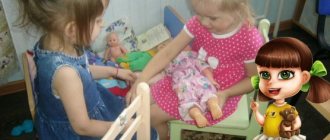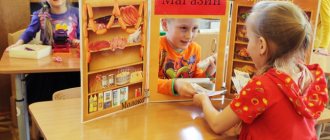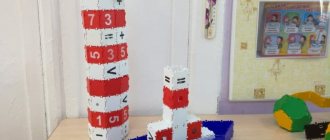The importance of role-playing games in the upbringing and development of a child
For a preschool child, play is a leading activity, a form of organizing life activity, and the main means of comprehensive development.
Starting from early preschool age, children show interest in play. However, they do not fully master gaming skills, and therefore children are very interested in playing with an adult. By middle preschool age, children already know how to play with each other; one of the most interesting games for them is role-playing game.
Definition 1
A role-playing game is a game that has a specific plot - a series of interconnected events and situations, and the roles that are distributed among its participants, and are the main core of the game.
Are you an expert in this subject area? We invite you to become the author of the Directory Working Conditions
Role-playing games are aimed at developing memory, thinking, imagination and personality in general in preschoolers.
The pedagogical value of a role-playing game lies in the fact that in addition to the relationships that are dictated to children by the plot of the game, other real and actual ones arise between them. During the game, children learn to interact with each other, understand how they relate to successes and failures, and learn to resolve conflict situations. The game helps the child overcome his timidity and embarrassment, and develops a variety of skills (work, play, communication, etc.), depending on the plot of the game.
Role-playing games teach children to independently establish relationships with the team and develop productive communication skills.
The game can be organized by a teacher who explains the plot to the children, assigns roles and manages the entire process of the game. The game can also be organized by children independently. When organizing the game independently, children themselves assign roles and follow the development of the plot. The game can be organized by children based on a fairy tale they read, a cartoon they watched, or the plot can be invented spontaneously (for example, a game of school, hospital, etc.).
Finished works on a similar topic
Course work Role-playing game, its role in the upbringing and development of a child 440 ₽ Abstract Role-playing game, its role in the child’s upbringing and development 230 ₽ Test work Role-playing game, its role in the child’s upbringing and development 220 ₽
Receive completed work or specialist advice on your educational project Find out the cost
In the process, role-playing games and joint play activities help children develop organization, responsibility, self-control and self-regulation skills, and consistency with the actions of other children. As the plot of the game develops, children acquire planning skills, creative imagination, initiative, activity, determination, etc.
Note 1
Thus, the role of role-playing games in the upbringing of a preschool child is very great, since it contributes to the comprehensive and complete development of the child’s personality and the formation of the necessary skills and abilities.
Let's play at life
There is no game without a plot.
The plot is the main element of a role-playing game. There will be no game without it. The plot is the area of activity that children reproduce. While playing, a preschooler reproduces actions, events, relationships from life, while his play actions (examining a patient, preparing a pie, building a house, etc.) are the main means by which he realizes the plot. The plots of the games are different.
“Did you know that game plots change over time? Their content depends on the historical period, the state of the country’s economy, natural and geographical features of the area, and cultural traditions. There are also plots of games without time, for example, in “Hospital”, “Family”, “School”.
The next important element of the game is its content , which the child embodies through a certain role. The role is the main component of the game and the means of implementing the plot. A role for a child is his position. That is, the child, accepting a role, identifies himself with some hero and lives in the game according to the principle of conformity to this role, based on his own ideas. The role is based on rules of behavior that the baby borrows from the adult world, adopting the behavior of adults. Already at three years old, the child wants to act not only independently, but also like an adult.
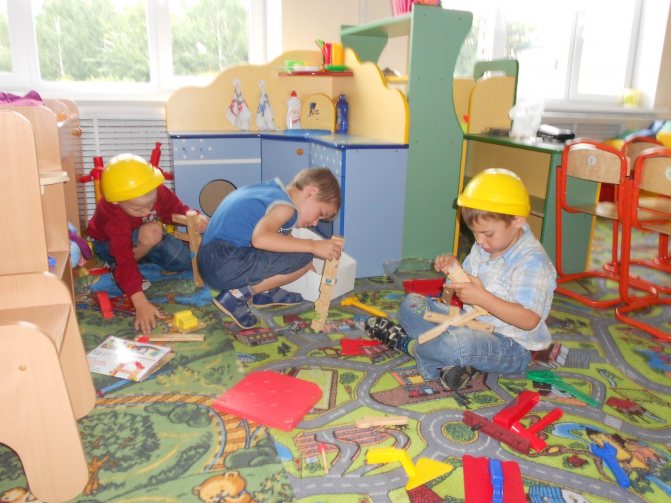
One of the features of role-playing games is their social orientation
Features and benefits of role-playing games:
- Certain rules and their observance by children.
- Social orientation of games.
- Rich emotional palette.
- Development of intelligence.
- Active development of creativity.
- Speech development.
By playing role-playing games, the baby develops intensively and diversified.
MAGAZINE Preschooler.RF
The importance of role-playing games in the life of a preschoolerN.V. Mikhachik, teacher at MBDOU “Child Development Center – Kindergarten No. 9 “Rodnichok”, Nyandoma
“A game is in no way an exercise in some particular function. This is the form of life of a preschooler, the main means of his development and the formation of specific human abilities...” D.B. Elkonin
In the context of the implementation of the Federal State Educational Standard and the requirements for the basic general education program of preschool education, a significant difference is the exclusion of educational activities from the educational process as not corresponding to the patterns of child development at the stage of preschool childhood. It becomes urgent for preschool teachers to search for other forms and methods of working with children.
At each age, there is a leading activity, within which new types of activity arise, mental processes develop, and mental new formations arise.
Play is undoubtedly the leading activity of a preschooler. It is through play that a child learns about the world and prepares for adult life. When properly organized, the game creates conditions for the development of the child’s physical, intellectual and personal qualities, the formation of prerequisites for educational activities and ensuring the social success of the preschooler. Three interconnected lines of child development: feel-know-create harmoniously fit into the child’s natural environment - a game, which for him is both entertainment and a way of understanding the world of people, objects, nature, as well as the sphere of application of his imagination. The game acts as a kind of bridge from the world of children to the world of adults, where everything is intertwined and interconnected.
A number of conditions contribute to the successful implementation of gaming activities and increasing the effectiveness of play development in preschoolers:
- Free and voluntary inclusion of children in the game: not imposition of games, but involvement in it.
- Children must understand well the meaning and content of the game, its rules, and the idea of each game role.
- The game should have a positive impact on the development of the emotional-volitional, intellectual and rational-physical spheres of its participants. With the help of the organization of gaming technologies, children are given the social experience of playing (teaching gaming skills).
- A sufficient amount of time for play and the availability of those toys that help children realize their plans, i.e. creation of an object-game environment.
- When creating a play environment, the gender differences of children should be taken into account (the interests of both girls and boys should be respected equally); carry out timely changes in the play environment, taking into account the enriching life and play experience of children and in accordance with their interests.
There are different types of games - active, didactic, theatrical and role-playing.
Psychologists rightly believe that role-playing play is the highest form of development of children's play. The child grows and develops, and the game develops with him - from the simplest everyday plots he moves to more complex ones, reflecting all areas of human activity.
Role-playing games are of great importance in the mental development of a child, developing voluntary attention, memory, imagination, and creativity. The rules that are mandatory when playing the game instill in children the ability to control their behavior, impulsiveness, and negotiate with partners, contributing to the formation of character. While playing together with peers, children learn to communicate and the ability to take into account the desires and actions of others.
Playing a role-playing game, getting used to some image, the child reproduces his impressions, rethinks and reveals them.
The basis of the role-playing game is an imaginary or imaginary situation, which consists in the fact that the child takes on the role of an adult and performs it in a play environment created by him.
Children's independence in role-playing games is one of its characteristic features. Children themselves choose the theme of the game, determine the line of its development, decide how they will reveal the roles, where the game will unfold, etc.
Each child is free to choose the means of embodying the image.
The main structural component of a role-playing game is the plot. Without it there is no game itself. Throughout human history, the plots of children's games have changed.
The stories are divided:
- Social services (family, kindergarten)
- Production ones, reflecting the professional work of people (games of hospital, store, car, etc.).
- Public (celebration of City Day, school)
Another structural component of a role-playing game is content.
The content of the game is what is reproduced by the child as the central and characteristic moment of activity and relationships between people in their everyday and social activities (D. B. Elkonin).
The content of the role-playing game is embodied by the child through the role he takes on. A role is a means of realizing the plot and one of the main components of a role-playing game.
Every role contains its own rules of behavior, taken by the child from the life around him. Submission of the child to these rules is the most important element of role-playing play.
In the game, as in any activity of children, the teacher plays a leading role. In the game, adults teach children a lot and shape their moral qualities.
The teacher's advice and suggestions support the children's interest in the game and help bring it to the end. This is important for developing perseverance and focus in preschoolers.
When leading a role-playing game, the teacher must always remember that it is necessary to develop the initiative, independence of children, preserve their spontaneity, and the joy of play. Any kind of coercion should be excluded from the methods of managing the game, never fantasize for the child, do not invent a game for him. Only with such guidance does gaming creativity develop successfully.
Methods of managing children's play can be divided into traditional (R.I. Zhukovskaya, D.V. Mendzheritskaya) and new (N.Ya. Mikhailenko, N.A. Korotkova, E.V. Zvorygina, S.L. Novoselova)
D.V. Mendzheritskaya argued that the teacher has the right to intervene in the game if this is required in order to give her the right direction. But an adult’s intervention will only be successful when he enjoys sufficient respect and trust from children. She believed that the main way a teacher influences children’s play and raising children in play is through influence on its content, i.e. on the choice of topic, plot development, distribution of roles.
A N.Ya. Mikhailenko and N.A. Korotkova believe that in order for children to master gaming skills, the teacher must play with the children. They propose to consider the management of role-playing games as a process of gradually transferring to preschoolers increasingly complex ways of constructing a game. The transfer is carried out in joint play between an adult and children.
Techniques for directing a role-playing game can be direct and indirect.
Direct guidance involves direct adult intervention in children's play. It can be expressed in role-playing participation in the game, in participation in the collusion of children, in clarification, in providing assistance, advice during the game, or in proposing a new topic for the game.
Indirect guidance of play is especially fruitful when working with preschool children. The teacher expresses his judgments while playing with children exclusively in the form of advice, without demanding strict obedience.
Watching the play of children in the second younger group, we saw that children not only play little, but also do not know how to play. This means that the child does not develop activity, imagination, creativity, or important communication skills. We set ourselves the goal of teaching children to play role-playing games. And through play, expand children’s knowledge about the work of adults. For the first acquaintance with this topic, we chose the profession of a doctor.
Based on these goals, we developed the project “Introduction to the professions of a doctor and a nurse .
Project participants: teacher, medical worker, children and parents of the second junior group.
Project type: short-term; cognitive-research; creative and informational.
Problem: Every profession is unique. Children of primary preschool age do not have clear ideas about the variety of work activities of adults. Children do not clearly understand the specifics of a doctor’s work, what objects he needs in his work, and do not know how to develop role-playing interaction - role-playing dialogue.
The relevance of the project lies in the fact that through acquaintance with the professions of a doctor and a nurse, preschoolers enrich their knowledge and ideas about the work of adults, expand their vocabulary, and also learn about the importance and significance of this profession.
The goal is to form a holistic understanding of preschoolers about the profession of a doctor and nurse through different types of children's activities.
Tasks:
- To develop in children the ability to play according to their own plans, to stimulate children’s creative activity in play.
- To form friendly relationships in the game, a sense of humanism, activity, responsibility, friendliness.
- Help create a game environment, establish interaction between those who have chosen certain roles.
- Enrich children's understanding of the profession of a doctor and nurse;
- Continue to accumulate and expand children's vocabulary;
- Develop the ability to reproduce in play various actions that children observe in life, using substitute objects;
- Develop children's creative abilities through productive activities;
- Develop activity and curiosity.
Planned result:
- Gaining knowledge about the profession of a doctor and nurse;
- Expanding children's vocabulary;
- The ability to reproduce in play various actions that children observe in life;
- Development of communication skills;
- Development of creative abilities in children.
- Development of such qualities as: curiosity, activity.
Project stages:
1. Organizational and preparatory stage
- collection of material necessary for the implementation of the project;
- development of notes of conversations, game situations;
- updating attributes for role-playing games;
- production of didactic games and manuals;
- selection of fiction;
- replenishment of the development environment;
- preparing an album with plot pictures on the topic “The work of a doctor and a nurse .
2. Practical (main) stage
- Conversations “Who will come to our aid?” , “How should you behave in a doctor’s office?” , “Why do we need vaccination?”
- Reading fiction by K. Chukovsky “Aibolit” , V. Suteev “About the hippopotamus who was afraid of vaccinations” , E. Blaginina “Sick Bunny” .
- Discussion of plots, actions of heroes.
- Excursion to the medical office.
- Game situations “Katya the doll got sick” , “So that the tooth bites” .
- Didactic games “Useful - harmful” .
- GCD "What's in the bag?"
- Looking at pictures on the topic “The work of a doctor and a nurse .
- Making a poster “What’s in a doctor’s suitcase?”
- GCD (drawing) “Onion”
- GCD (modeling) “Vegetables and fruits”
- GCD (application) “Ambulance”
- Board games: “Professions” , “Profession Lotto” .
- Parents' help in replenishing the "hospital" - sewing doctor's and nurse's gowns.
- Design of travel folders for parents on the topics: “Healthy lifestyle” , “Role-playing game” , “Role-playing games for children from 2 to 4 years old” , “Games with dolls” .
3. Final stage
- Organization of the role-playing game “Hospital”
- Exhibition of children's works
- Presentation “Introduction to the professions of a doctor and a nurse”
Observing preschoolers in their activities, we noticed that at the end of the project the children began to use the role-playing game “Hospital” and played it with great interest and success.
Children have developed basic gaming skills that allow them to deploy a number of interconnected conditional objective actions during the game and attribute them to a specific character (role).
Analyzing the results of the project, we realized that the use of role-playing games for the comprehensive development of a child and the formation of his positive personal qualities is very relevant.
List of information sources:
*
- Elkonin D.B. Psychology of the game. M., 1978
- Zvorygina E.V. Children's first story games. M: Enlightenment. 1988
- Zvorygina E. Komarova N. Pedagogical conditions for the formation of role-playing games. // Preschool education. 1989 No. 5.
- Mikhailenko N.Ya. Organization of story-based games in kindergarten: a manual for teachers / N.Ya. Mikhailenko, N.A. Korotkova. – 3rd ed., rev. – M: LINKA-PRESS, 2009.
- Tkachenko I.V., Bogachkina N.A. I play - it means I live interestingly. M: DROFA, 2008
| Next > |
Role-playing games for children 3-4 years old
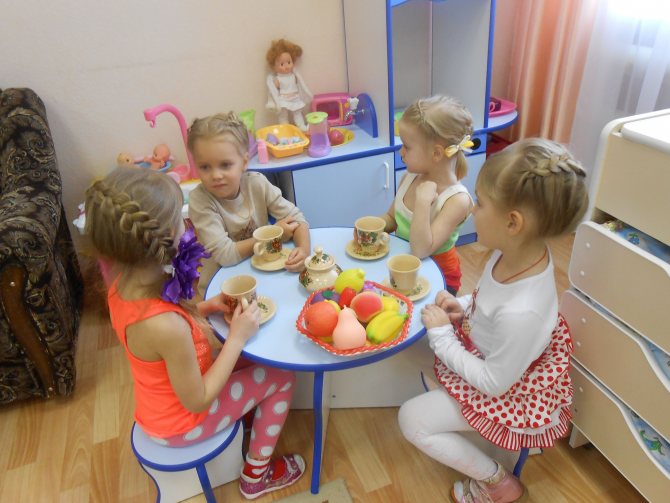
The games of younger preschoolers differ in content from the games of older children. This is due to the insufficient experience of children, the characteristics and level of their mental and emotional development, and cognitive processes. The baby cannot yet imagine the entire gameplay in his imagination and grasp the logical chain of events following each other. Therefore, the content of children’s games at first is not entirely logical, fragmentary, and somewhat incoherent. In early childhood, children repeat simple actions with toys that adults show them.
“The games of younger preschoolers consist of everyday activities: children carry, ride, cook, bathe, etc. A little later, roles appear: I am a doctor, I am a driver, I am a mother. The chosen role directs the child’s play: now the baby chooses only those actions that are characteristic of the chosen role: for example, “mother” chooses food and dishes for preparing dinner, the doctor needs a thermometer, etc. Children use both symbolic and imaginary objects for play , and real."
At the turn of three and four years, the child’s games become more interesting. This is due to the fact that children acquire new knowledge about the world. Children are already combining various events, including in games elements of plots from their experience or children's works (fairy tales, cartoons).
For a child of middle preschool age, the choice of role becomes important: the child wants to play the role that he likes.
The plot-play activity of a 3-4 year old child is of the following nature:
- the presence of individual game actions of a gaming nature
- actual implementation of a role without naming it
- the plot is a chain of two actions
- adult participation in holding an imaginary situation.
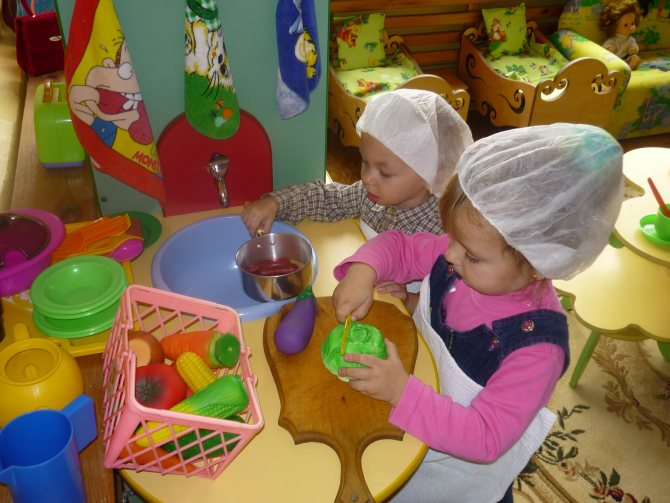
Here are some examples of games that will be interesting for a 3-4 year old child:
- "Let's go for a walk."
Goal: teaching a child how to select clothes for the season, learning the names of clothing items and their elements.
Contents of the game: the child prepares the doll for a walk, choosing the right clothes for it, carefully dressing the doll in the correct sequence, naming the clothes.
- “To the store for shopping.”
Goal: teaching children to name and classify objects, expanding their vocabulary, developing a communicative culture for preschoolers, and teaching the basics of politeness.
Contents of the game: you need to distribute the roles, who is the seller, who is the buyer, and play the game in accordance with the roles. Buyers visit the store, choose purchases, and the seller politely serves them.
- "At the doctor".
Goal: teaching the child attentiveness, sensitivity, caring for the sick, understanding the functions of medical devices, increasing vocabulary.
Progress of the game: the child plays the role of a doctor, and the toys play the role of patients. Patients come for an appointment, the doctor must examine them, make a diagnosis, prescribe and carry out treatment.
- "The doll's birthday."
Goal: expanding the child’s knowledge about setting the table for a festive dinner, consolidating knowledge about cutlery and cutlery, instilling attentiveness, caring, responsibility, a desire to help, and expanding vocabulary.
Contents of the game: you need to tell the child that today is the Marina doll’s birthday. The child takes the toys and goes to visit the doll, congratulates her, and then the doll invites everyone to the table to treat themselves to a birthday cake and tea. The child must help the doll set the table.
- "Home construction".
Goal: to familiarize the child with construction professions, tools and equipment that make the work of builders easier, to learn how to build a simple structure, to expand knowledge about the profession of a builder, to improve vocabulary by introducing the concepts of “building”, “builder”, “building material”.
Contents of the game: invite your child to build a spacious, bright house from cubes or other materials in which toys would live. At the same time, introduce your child to construction professions by showing thematic images and offering to play one or another profession: bricklayer, painter, carpenter, crane operator, truck driver, etc.
